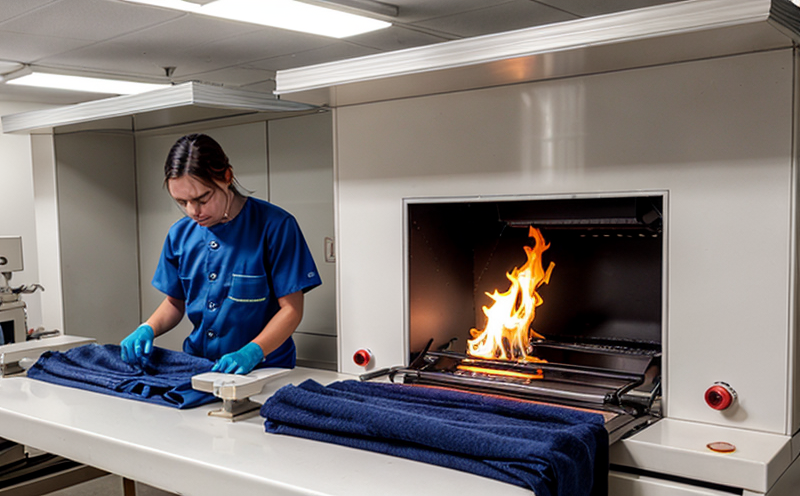Documentation and Reporting of Textile & Apparel Fire Tests
The documentation and reporting of textile and apparel fire tests are critical steps in ensuring product safety and regulatory compliance. This process involves meticulous recording of test procedures, results, and interpretations to provide stakeholders with a comprehensive understanding of the material's flammability properties.
Firstly, it is essential for quality managers to understand that documentation should encompass all aspects of the testing procedure—from sample preparation through to final reporting. This ensures that any discrepancies or anomalies can be traced back to their source, thereby maintaining transparency and integrity in the data provided. Compliance officers will benefit from this detailed record-keeping process as it helps them stay updated on changes within relevant standards like ISO 13565-2 for horizontal flame tests.
R&D engineers play a crucial role here too; they need accurate documentation to refine formulas or improve designs based on real-world performance metrics. For procurement teams, having reliable test reports allows them to make informed decisions about sourcing raw materials and manufacturing processes that meet strict safety requirements without compromising quality.
A well-documented fire test also serves as a powerful tool during product launches by demonstrating adherence to international regulations such as those outlined in EN 13925-1 for children’s sleepwear or ASTM D6473 for fabric flammability testing. By providing clear evidence of compliance, businesses can build consumer trust and confidence which is vital given increasing awareness around fire safety issues.
In summary, thorough documentation not only supports regulatory requirements but also plays a key part in enhancing product performance through continuous improvement efforts. It provides valuable insights into how different fabrics behave under various conditions aiding in the development of safer products for end users.
- Comprehensive Record Keeping: Detailed records ensure traceability and transparency throughout the testing process.
- Regulatory Compliance: Accurate documentation helps businesses meet stringent safety standards set by international organizations.
- Informed Decision Making: Reliable test reports guide procurement teams in selecting appropriate materials for production.
- Product Improvement: Real-world data from fire tests can be used to enhance product design and functionality.
Why Choose This Test
The choice of textile and apparel fire testing is driven by the need for robust evidence proving that fabrics comply with stringent safety regulations. These tests help manufacturers ensure their products meet strict flammability thresholds, thereby protecting consumers from potential hazards associated with improperly designed or manufactured garments.
For instance, when selecting a flame retardant fabric, it’s important to choose one that has been rigorously tested according to established methods like ISO 13565-2. This standard specifies the procedure for conducting horizontal flame tests on textiles and provides criteria against which results must be measured. By following these guidelines, manufacturers can guarantee their products will pass regulatory inspections and provide peace of mind to customers.
Moreover, choosing this type of test allows businesses to stay ahead of market trends by incorporating cutting-edge technology into product development cycles. As societal attitudes towards sustainability evolve, so too do consumer expectations regarding eco-friendly manufacturing practices. Implementing sustainable solutions early on ensures brands remain relevant and competitive in today’s marketplace.
In conclusion, opting for textile and apparel fire testing is not just about compliance; it's also about building trust with consumers who increasingly demand safe, high-quality products made responsibly. By investing in this service, companies demonstrate their commitment to both human safety and environmental responsibility.
Quality and Reliability Assurance
The process of ensuring quality and reliability in textile and apparel fire testing is rooted in rigorous adherence to international standards such as ISO 13565-2. These guidelines provide a structured framework that laboratories follow when conducting tests, which helps maintain consistency across different facilities and regions.
Quality assurance begins with proper sample preparation, where technicians ensure samples are representative of the actual product being tested. This involves careful selection based on size, type, and condition to avoid bias in results. Once prepared, specimens undergo precise testing using advanced instrumentation like calorimeters or cone testers depending upon the specific test required.
Reliability assurance comes into play during the entire lifecycle of a textile fire test—from initial consultation through final report issuance. Regular calibration of equipment ensures accurate measurements while continuous training for personnel guarantees they are up-to-date with best practices and methodologies recommended by organizations like ASTM or EN. Additionally, implementing strict quality control measures helps identify any inconsistencies early on so corrective actions can be taken immediately.
In summary, maintaining high standards throughout every stage of the testing process is paramount to delivering reliable results that instill confidence among stakeholders. By doing so, laboratories contribute significantly towards enhancing overall product safety and compliance with global regulations.
Competitive Advantage and Market Impact
Choosing textile and apparel fire tests offers significant competitive advantages for businesses operating in this sector. Firstly, it enhances brand reputation by demonstrating a strong commitment to consumer safety—a key factor influencing purchasing decisions today. Secondly, compliance with stringent flammability standards opens up new market opportunities domestically and internationally.
- Increased Market Share: Meeting or exceeding regulatory requirements can set brands apart from competitors who may not adhere as closely.
- Better Consumer Trust: Brands that prioritize safety earn greater loyalty and trust among consumers, leading to higher sales volumes.
- Global Expansion: Demonstrating compliance with international standards like ISO 13565-2 can facilitate entry into foreign markets where stringent regulations apply.
- Premium Pricing: Products that pass rigorous fire tests often command premium prices due to their perceived enhanced quality and safety.
Moreover, early adoption of sustainable practices through responsible sourcing and manufacturing processes can further strengthen a brand's position in the market. Consumers are increasingly seeking out companies that demonstrate environmental consciousness, making it an attractive differentiator for textile and apparel manufacturers.
In conclusion, investing in comprehensive fire safety testing is more than just meeting regulatory obligations; it’s about positioning oneself strategically to capitalize on growing consumer demand for safer, higher-quality products while maintaining a competitive edge in the global market.





